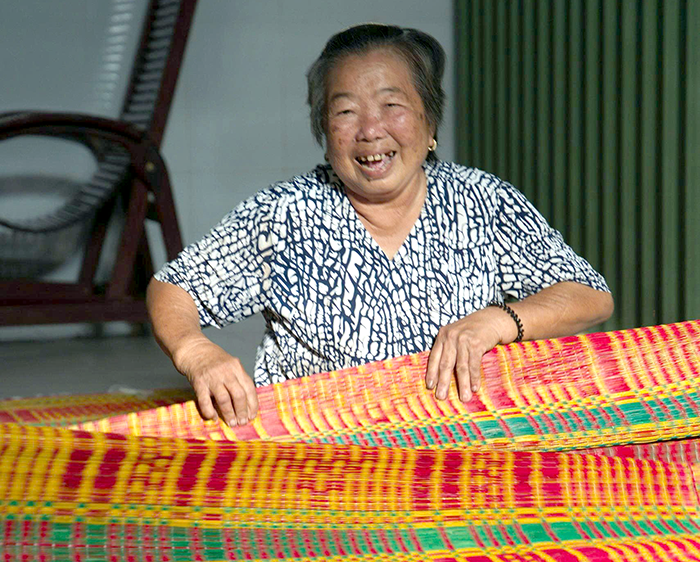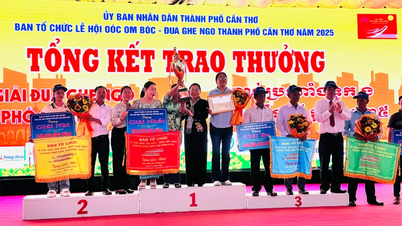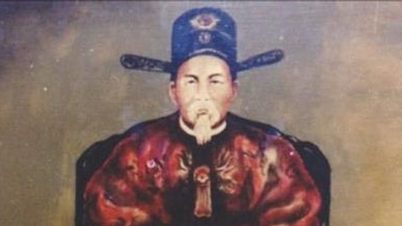
The exquisite floral mats have just been completed by artisan Diep Thi Som.
Keeping the profession from childhood
The small road leading to Ham Tan commune, Tra Cu district, Tra Vinh province (now Ham Giang commune, Vinh Long province), the deeper into the center, the more bundles of golden rushes are dried under the sun on both sides of the road. Busily turning each bundle of rushes to dry quickly, every weekend, Ms. Kim Thi Hong Hoa, a secondary school literature teacher, returns to her familiar job. She confided: “This rush is partly grown at home, partly bought. I have known how to weave mats since I was a child. During teaching hours, whenever I have free time, I sit at the mat frame. This job is hard, but it nurtures a love of work and preserves traditional beauty.”
Following the small path, in a simple house, Ms. Tran Thi The weaves mats and confides: “This job has been with me since I was little until I got married. In my free time, I weave mats, earning an average of about 6 million VND/month, and the women in the neighborhood also earn a few million VND for groceries.” She adds: “In the past, every house had a loom. When women grew up, they knew how to weave, while men split and dyed sedge. People in the village lived on mats, and they also used them to educate their children. Weddings, funerals, festivals, etc. always had mats, they were attached to the lives of the people here.”
Ca Hom mats are famous for their durability, coolness, and sophisticated patterns. The craftsmen use sedge - a specialized grass to make the mats, dry them, and dye them. This process takes nearly a month before they are brought to the weaving loom to create mats with many patterns. A beautiful mat takes a whole week to complete, but lasts for 4-5 years.
Promoting heritage values
In a small house, artisan Diep Thi Som, now with white hair and calloused hands, is steadily moving the shuttle through the loom. At the age of seventy, she is still attached to the traditional craft that she calls “her career”.
Mrs. Som said: “This profession has existed since the time of our great-grandparents, around the end of the 19th century. At that time, Khmer people in Ham Tan area planted sedge on the alluvial land along the river, both to roof houses and to weave mats for use. Gradually, mats became precious gifts during Tet and weddings, and then became commodities to be traded throughout the South.” According to her, in the 1940s, Ca Hom mats were famous for their durability and sophisticated patterns. The craftsmen used 5 main colors: white, red, blue, yellow, purple to weave a pair of double-sided flower mats. Each mat requires a keen eye, patient hands, meticulousness and aesthetic sense.
There was a time when Ca Hom mats were the pride of the entire Southern region, with traders from all over coming to order. In the 1960s and 1970s, mats from Ham Giang were carried by boats and canoes to all canals and regions. However, when plastic mats appeared, the craft village struggled. Many households abandoned the profession because of the scarcity of raw materials and slow innovation in designs.
Leading us into the house, Mrs. Som pointed to the newly woven mats with bright patterns. The durable mats with bright patterns have become a cultural feature in many families. However, Mrs. Som still worries: “The biggest worry is that the young generation is no longer interested. If there is no attention, the sound of the loom will gradually fade away, and it would be a pity if it were lost.”
Mr. Thach Boi, Deputy Director of the Department of Culture, Sports and Tourism of Vinh Long province, said that preserving and promoting the value of Ca Hom mat weaving village is an extremely important task, closely linked to the cultural identity of the Khmer ethnic group. In December 2024, the Ministry of Culture, Sports and Tourism officially included the traditional Ca Hom mat weaving craft in the List of National Intangible Cultural Heritage, affirming the everlasting value of mat weaving, opening up new opportunities to preserve and develop the craft village in the modern context.
“The provincial Department of Culture, Sports and Tourism coordinates with localities to organize training classes, support people to improve designs, connect with the market and experience tourism. At the same time, encourage the younger generation to participate, both to have more jobs on the spot and to contribute to preserving cultural identity,” said Mr. Thach Boi.
| In 2001, the People's Committee of Ham Giang commune supported the cost of building weaving frames for 40 poor households and invited artisans to teach the craft to the younger generation. Currently, the locality has more than 450 households following the craft, nearly 500 weaving frames in operation, creating stable jobs for about 1,000 direct workers and more than 1,500 indirect workers. On the occasion of Tet, the whole village is busy, producing more than 1,000 pairs of mats each day, bringing in hundreds of millions of dong in revenue. The locality currently has more than 37 hectares of sedge land, basically meeting the raw material needs of the craft village. |
Article and photos: OCEAN
Source: https://baocantho.com.vn/tram-nam-nghe-chieu-ca-hom-a193428.html





























![[Photo] Opening of the 14th Conference of the 13th Party Central Committee](https://vphoto.vietnam.vn/thumb/1200x675/vietnam/resource/IMAGE/2025/11/05/1762310995216_a5-bnd-5742-5255-jpg.webp)
![[Photo] Panorama of the Patriotic Emulation Congress of Nhan Dan Newspaper for the period 2025-2030](https://vphoto.vietnam.vn/thumb/1200x675/vietnam/resource/IMAGE/2025/11/04/1762252775462_ndo_br_dhthiduayeuncbaond-6125-jpg.webp)
















































































Comment (0)